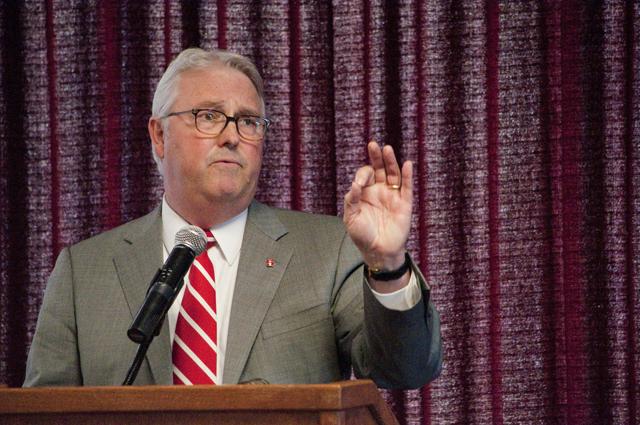Leaders talk about budget cuts, implementation of 5-year plan
Chancellor Randy Woodson, in the company of many higher-education leaders, outlined the ramifications of Gov. Pat McCrory’s proposed budget during a Faculty Senate meeting Tuesday. The proposed cuts on education present many challenges, Woodson said.
McCrory’s budget may cut up to $139 million from the UNC System. The Chancellor reaffirmed at the meeting that he is lobbying to fight the proposed cuts, which have yet to be approved by the General Assembly. The chancellor said he’s been lobbying for the UNC System a week before the budget was announced, and today Woodson will be at the General Assembly to advocate further.
Following Woodson and Provost Warwick Arden, who discussed strategic plans, UNC System President Tom Ross briefly explained a five-year plan for the school system at the meeting.
The Budget
Woodson said under McCrory’s plan the University would lose $43 million in the first year and “$30.6 million on a non-recurring basis.”
The governor proposed an additional tuition increase, a 12.3 percent increase for out-of-state students. McCrory’s proposed tuition raise exceeds that the Board of Governors has approved.
“It’s better than it could have been,” Woodson said.
Evidently, McCrory had planned to raise tuition on international graduate students, Woodson said.
“We would be the first campus in America to specifically charge a student more in tuition from India as compared to Indiana,” Woodson said. “This is not good. This would have sent a very strong signal for the state of North Carolina that would not be complimentary of any of our universities, or frankly, it would have a huge impact on the industries in the Triangle that rely on a lot of the talent that we produce.”
Woodson said the final budget the governor put forth did not include any tuition raise on international students.
For the sake of the University’s reputation, Woodson said the out-of-state tuition increases should not affect undergraduate students as to encourage more to attend the University.
According to Chancellor Woodson, the budget the General Assembly will put forth may not be the same as Gov. McCrory’s. The legislature holds a supermajority among Republicans, and the McCrory administration has yet to face much opposition in the General Assembly.
On one hand, McCrory’s proposed budget fully funds enrollment growth, according to Woodson, and would allot about $50 million to the university system.
“Obviously, N.C. State being one of the campuses that continues to expand — primarily in graduate enrollment,” Woodson said. “We’re a big part of enrollment growth funding, and that’s a good thing.”
On the other hand, McCrory proposed about a $139 million reduction to management and flexibility budget that all campuses use to operate, Woodson said.
Though Woodson was not expected at first to speak at the Faculty Senate meeting, his presence shows the urgency of budget process.
“We’ve got some pretty big fish to fry,” he said. “We hope we can have influence over this in the General Assembly, and we’re going to work hard to do that.”
The Strategic Plan
Ross said the five-year plan for the system the Board of Governors put forth includes the possibility of doing away with general education courses as well as paying more attention to retention versus graduation rates.
“There are people — I’m not one of them — who think there should be a prescribed set of courses [to get] a degree,” Ross said.
Ross said he would rather focus on training students toward competencies relevant to their prospective vocation than have students take courses that have no bearing on their employment.
The president also said the Board of Governors wants to fund more job-earning degrees than not.
Of all North Carolina adults, only 26 percent have a Bachelor’s degree or higher, according to Ross.
The president maintained that by the end of the five-year plan, 32 percent of adults in the state should have at least a Bachelor’s degree. Staying on that trajectory, North Carolina could be in the top 10 educated states by 2025, Ross said.
The plan includes making transfers easier so as to reduce the factors in students’ retaking courses, according to Ross. He also said he hopes to target North Carolina adults who have some type of college credit but no degree.
Ross did not say anything that showed support or opposition to Gov. McCrory’s established stance on liberal arts degrees. He did say, when presenting the plan to prospective Chapel Hill chancellors, the potential chancellors supported the plan.
“There are parts of the plan people agree with and parts they don’t,” Ross said. “I’m happy to talk about that, but I think it’s very helpful that we have a plan.”
Provost Arden also briefly outlined the strategic and action plans established in spring and fall of 2011, respectively.
The strategic plan, according to Arden, would require a $114 million continuing budget. It would also require a $208 million cumulative one-time cost and $198 million cumulative cost for new faculty space.
Arden emphasized growth of faculty, increasing graduate and post-doctorate enrollments and hiring more academic advisors.
The figures for the strategic and action plans are all projections for 2020.
Editor’s note: This article has been modified since it was originally published.
I think there is a held view from the General Assembly that we’ve been funded at a very high rate for a long time. Some of that is true. But we hope we can have influence over this in the General Assembly, and we’re going to work hard to do that.
– Chancellor Randy Woodson








